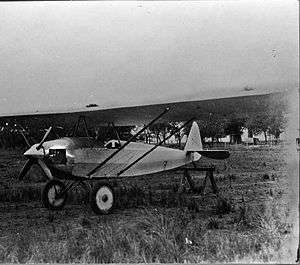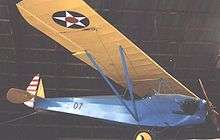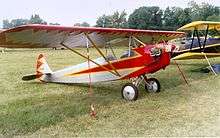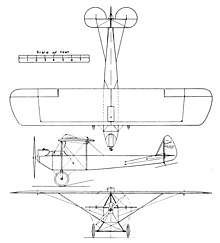Heath Parasol
The Heath Parasol is an American single-seat, open-cockpit, parasol winged, homebuilt monoplane.
| Heath Parasol | |
|---|---|
 | |
| Parasol, photographed in 1935[1] | |
| Role | amateur-built airplane |
| National origin | United States |
| Manufacturer | Heath |
| Designer | Edward Bayard Heath |
| First flight | 1926 |
| Introduction | Parasol (1926); 1927 (Super Parasol); 1930 (V Parasol; 1931 (LN Parasol) |
| Primary user | Recreational flyers |
| Unit cost |
US$975 fly-away price for a Super Parasol in the late 1930s |
Design and development

.jpg)
During the late 1920s and early 1930s it was the only airplane that could be constructed at home from a factory-built kit and be licensed by the FAA. The Heath was extremely popular, being economical to build and operate, and easy to fly.
Modern Mechanix magazine published plans[2] and subsequently, Heath sold nearly 1,000 kits on an installment basis. Fewer than 50 were factory built, but several hundred were completed and flown by homebuilders during the depression. Heath is remembered today for having helped pioneer the homebuilt aircraft industry and for having introduced the kit concept of packaging the materials needed to build an aircraft.


The fuselage is built of welded steel tube and is fabric covered. The wings consist of two solid spruce spars, built up wooden ribs, compression struts and internal bracing. The Parasol's empennage is built of wood, the tailplane being externally braced. Two five gallon fuel tanks are installed at the root end of each wing, the fuel being gravity fed. The only tools necessary to assemble one of the Parasol kits were a pair of small pliers, screwdriver, hacksaw (with plenty of blades), hammer, small hand drill, chisel, center punch, file and drill.
A variety of powerplants could be fitted, including the factory-supplied converted Henderson Motorcycle engine (viz. 25 hp (19 kW) Heath-Henderson B-4). Building a Heath Parasol requires basic woodworking skills and tools. Builders also need to fabricate some metal fittings to attach the wooden parts together. Some welding is required. The plans for the Parasol were also originally published in the "Flying and Glider" Manual.
Production of an early version was undertaken as early as 1931, in Australia, by the Adcock-Heath Company.
Variants
- LNA-40
- Powered by 40 hp (30 kW) Continental A40. Granted FAA type certificate[3]
- LNB-4
Survivors
- There is a LNB-4 Parasol on display at the New England Air Museum, Bradley International Airport, Windsor Locks, CT.[4]
- The Museum of Flight, Seattle, WA, owns a Parasol. It is currently at their Restoration Center in Everett, WA. [5]
Specifications (Parasol)

Data from Aviation[6]
General characteristics
- Crew: 1
- Length: 17 ft 0 in (5.18 m)
- Wingspan: 25 ft 0 in (7.62 m)
- Height: 4 ft 6 in (1.37 m)
- Wing area: 110 sq ft (10 m2)
- Empty weight: 280 lb (127 kg)
- Gross weight: 580 lb (263 kg)
- Fuel capacity: 9 US gal (7.5 imp gal; 34 L)
- Powerplant: 1 × Heath , 27 hp (20 kW)
Performance
- Maximum speed: 70 mph (110 km/h, 61 kn)
- Cruise speed: 65 mph (105 km/h, 56 kn)
- Stall speed: 32 mph (51 km/h, 28 kn)
- Range: 270 mi (430 km, 230 nmi)
- Service ceiling: 12,500 ft (3,800 m)
- Rate of climb: 500 ft/min (2.5 m/s)
See also
- Heathkit descendant company, maker of electronic kits
Aircraft of comparable role, configuration and era
- Dormoy Bathtub
- Aerotique Parasol
- Fisher FP-505 Skeeter
- Loehle Sport Parasol
- Pietenpol Air Camper
- Pop's Props Cloudster
- Pop's Props Zing
- Powell P-70 Acey Deucy
- RagWing RW5 Heath Replica
References
- Built by Methodist missionary Harold Shepherdson on Elcho Island in the remote Arnham Land region of northern Australia. It was built from an imported kit and fitted with DH.60 Moth main wheels and a 34 hp two-cylinder Bristol Cherub. The Reverend Shepherdson completed a number of ground runs in his Parasol before hitting a tree stump and severely damaging the aircraft. Its remains are now in the collection of the Australian Aviation Heritage Centre in Darwin.
- Air Progress Sport Aircraft: 70. Winter 1969. Missing or empty
|title=(help) - http://neam.org/index.php?option=com_content&view=article&layout=edit&id=864 "Heath LNB-4 'Parasol'"
- https://www.museumofflight.org/aircraft/heath-parasol
- "Manufacturer's Specifications on American Commercial Airplanes as Compiled by Aviation". Aviation. January 18, 1930. pp. inside front cover.
- 1929 Flying and Glider Manual
- Sport Flying Quarterly, Vol.9 No.7, 1975, pp 54–63.
External links
| Wikimedia Commons has media related to Heath Parasol. |